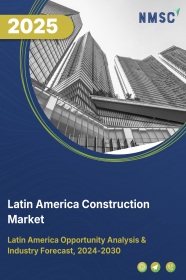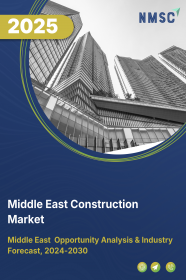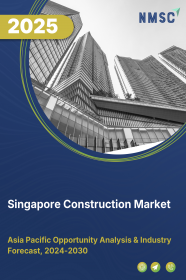
Latin America Construction Market by Type (Renovation, and New Construction), by Sector (Real Estate and Others), by Construction Method (Traditional Construction, Prefabricated/Modular Construction, 3D Printed Construction, Green/Sustainable Construction), and by Type of Contractor (Large Contractor, Medium Contractor and Small Contractor) – Regional Industry Trends and Forecast, 2025–2030
Industry: Construction & Manufacturing | Publish Date: 21-Jun-2025 | No of Pages: 183 | No. of Tables: 136 | No. of Figures: 85 | Format: PDF | Report Code : CM2225
US Tariff Impact on Latin America Construction Market
Trump Tariffs Are Reshaping Global Business
Latin America Construction Industry Overview
The Latin America Construction Market size was valued at USD 464.50 billion in 2024, and is projected to grow to USD 491.83 billion by 2025. Additionally, the industry is expected to continue its growth trajectory, reaching USD 514.29 billion by 2030, with a CAGR of 0.9% from 2025 to 2030.
The Latin America construction market encompassing both real estate and infrastructure, is driving significant economic development through a diverse range of projects, from residential to large-scale infrastructure initiatives.
Effective collaboration among stakeholders such as architects, contractors, government bodies, and private investors plays a key role in this growth, as seen in major projects like Brazil's Porto Maravilha urban redevelopment. The sector is also advancing with a focus on sustainability, adopting eco-friendly practices and materials, as demonstrated by Chile’s Santiago Metro Line 7 project.
Despite these positive trends, the market faces challenges due to complex regulatory frameworks and lengthy permitting processes that can delay projects and increase costs. However, the ongoing digital transformation, particularly with the adoption of Building Information Modeling (BIM), AI, and IoT technologies, presents significant opportunities to improve project efficiency, collaboration, and resource management, further contributing to market expansion.
Diverse Project Scope and Stakeholder Collaboration Boosts the Latin America Construction Market Growth
The Latin America construction market covering both real estate and infrastructure, plays a vital role in the region’s economic development by managing the entire lifecycle of various physical structures, including buildings and facilities. This sector encompasses a wide range of projects, such as residential, commercial, industrial developments, and civil and institutional infrastructure initiatives.
A notable example is Brazil’s USD 2.5 billion Porto Maravilha urban redevelopment project in Rio de Janeiro, which progressed in 2024 through public-private partnerships (PPPs). The project aims to revitalize the port area with new residential towers, commercial centers, and cultural venues.
Effective collaboration among diverse stakeholders’ architects, engineers, contractors, suppliers, developers, investors, and government bodies, including the Brazilian Development Bank (BNDES) has been crucial. In 2024, 70% of the project’s funding came from private investors. This wide-ranging project scope and strong stakeholder engagement, supported by the National Confederation of Industry (CNI), are significantly contributing to the growth of Brazil’s construction sector.
Sustainability and Economic Factors Propels the Latin America Construction Market Demand
The construction market in Latin America is also advancing due to a growing emphasis on sustainability and favorable economic conditions. The region is seeing increased adoption of eco-friendly construction practices, such as the use of green building materials and energy-efficient design strategies.
In Chile, the USD 1.2 billion Santiago Metro Line 7 project currently under construction in 2024 and scheduled for completion by 2028 embodies these principles through the use of low-carbon concrete and energy-efficient train systems. This aligns with Chile’s national goal of reaching 70% renewable energy by 2030. Additionally, economic factors like rising per capita income and accessible financing options are supporting market growth.
The Inter-American Development Bank (IDB), for instance, provided USD 300 million in 2024 to support sustainable infrastructure projects. These sustainability-focused initiatives and financial enablers are driving continued expansion of the Latin America construction market trends across the region.
Regulatory Complexities Hindering the Latin America Construction Market Expansion
Navigating regulatory complexities presents a significant challenge in the construction market. Infrastructure projects often face hurdles due to the intricate network of government regulations and permitting procedures.
Infrastructure initiatives require numerous permits and approvals from governmental bodies at local, regional, and national levels. These mandates include adherence to zoning regulations, environmental assessments, compliance with building codes, safety standards, and various other regulatory requirements.
Lengthy permit acquisition processes, bureaucratic inefficiencies, and regulatory disparities among different jurisdictions can significantly prolong project timelines and inflate costs. Moreover, fluctuations in regulations or unexpected policy changes can disrupt ongoing projects and deter potential investments in infrastructure market.
Integration of Digitalization and BIM Presents Lucrative Opportunity for the Market Expansion
The Latin America construction market share is experiencing a profound digital transformation, largely fueled by the growing adoption of Building Information Modeling (BIM), which is creating new growth opportunities.
Building Information Modeling (BIM) enhances digital design, simulation, and infrastructure management, boosting accuracy, collaboration, and resource efficiency. In line with this trend, ALLPLAN introduced Allplan 2024-1 in April 2024, aimed at improving BIM functionalities and optimizing cloud-based workflows, highlighting the sector's transition toward fully digital project delivery.
Additionally, the integration of AI, IoT, and cloud technologies is enabling more effective real-time collaboration, predictive maintenance, and streamlined facility management.
Competitive Landscape
The key players operating in the Latin America construction industry include Camargo Correa Construction Company, Techint Engineering & Construction, Sudamericana Construction Company SA, Criba Construcciones, SalfaCorp SA, Besalco, Odebrecht, Sigdo Koppers S.A., Constructora MECO S.A., Echeverria Izquierdo, OECI, IDEAL, S.A.B. de C.V., Cyrela Urbanismo, Andrade Gutierrez, and others.
Latin America Construction Market Key Segments
By Type
- Renovation
- New Construction
By Sector
-
Real Estate
-
Residential
-
Affordable
-
Luxury
-
-
Commercial
-
Retail Buildings
-
Office Buildings
-
Hospitality
-
Healthcare Facilities
-
Educational Institutes
-
Entertainment Ventures
-
-
-
Infrastructure
-
Transportation
-
Airport
-
Port
-
Rail
-
Road
-
-
Water and Wastewater
-
Energy
-
Telecommunication
-
-
Industrial
-
Manufacturing Plant
-
Warehouses
-
Power Plants
-
Oil Refineries
-
Chemical Plants
-
By Construction Method
-
Traditional Construction
-
Prefabricated/Modular Construction
-
3D Printed Construction
-
Green/Sustainable Construction
By Type of Contractor
-
Large Contractor
-
Medium Contractor
-
Small Contractor
Key Players
-
Camargo Correa Construction Company
-
Techint Engineering & Construction
-
Sudamericana Construction Company SA
-
Criba Construcciones
-
SalfaCorp SA
-
Besalco
-
Odebrecht
-
Sigdo Koppers S.A.
-
Constructora MECO S.A.
-
Echeverria Izquierdo
-
OECI
-
IDEAL, S.A.B. de C.V.
-
Cyrela Urbanismo
-
Andrade Gutierrez
REPORT SCOPE AND SEGMENTATION:
|
Parameters |
Details |
|
Market Size in 2024 |
USD 464.50 Billion |
|
Revenue Forecast in 2030 |
USD 514.29 Billion |
|
Growth Rate |
CAGR of 0.9% from 2025 to 2030 |
|
Analysis Period |
2024–2030 |
|
Base Year Considered |
2024 |
|
Forecast Period |
2025–2030 |
|
Market Size Estimation |
Billion (USD) |
|
Growth Factors |
|
|
Companies Profiled |
15 |
|
Market Share |
Available for 10 companies |
|
Customization Scope |
Free customization (equivalent up to 80 working hours of analysts) after purchase. Addition or alteration to country, regional, and segment scope. |
|
Pricing and Purchase Options |
Avail customized purchase options to meet your exact research needs. |

















 Speak to Our Analyst
Speak to Our Analyst

















